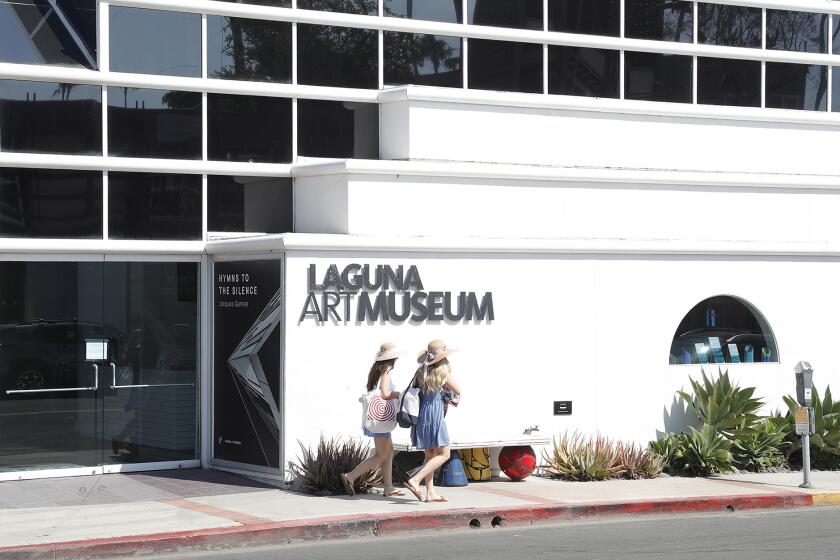Shack weathering storm
- Share via
Barbara Diamond
The Pottery Shack is history.
City Planners have recommended approval of a conglomeration of
shops, offices and restaurants to replace the hodge-podge of pottery,
china and housewares that drew tourists to Laguna Beach.
Only a vestige of the site’s history will remain, but the
exteriors of the buildings are to be preserved, except for a major
addition, under incentives and 54 conditions approved by the city’s
Heritage Committee and Planning Commission.
“This project is a complete remake,” former Planning Commissioner
Leah Vasquez said. “What the place looked like in 1964 is not what this is going to be, and there is no similar use.”
The project must be approved by the City Council and the
California Coastal Commission if the city’s coastal development
permit is challenged, as well as design review. A council hearing is
scheduled for Jan. 18.
Project Architect Morris Skenderian cautions that if not approved,
a whole new project will be submitted that the city and neighbors
will like a lot less. He said his goal is preservation.
“If someone else owned the property, it would be maxed out,”
property owner Joe Hanauer said. “It would be 50% larger, with more
traffic and a change in character.”
Hanauer’s proposal includes 3,769-square-feet of indoor and
outdoor dining area with seating for 113 people; 11,639-square-feet
of retail space and outdoor display; 4,081-square-feet of office
space on South Coast Highway and 4,508-square-feet of office space, a
156-square-foot deck and parking for 41 vehicles on Glenneyre Street.
A previous proposal, which did not include a newly-proposed,
1,867-square-foot addition, was approved 3-2 in July by council
members Toni Iseman, Cheryl Kinsman and Elizabeth Pearson. A
restaurant, which has an almost forgotten precedent on the site, was
included in both proposals.
“The restaurant is a totally new use and the developer is not
providing adequate parking for it,” Parking, Traffic and Circulation
Committee member Carolyn Wood said.
“If you add a restaurant to an existing project, you have to
provide additional parking.”
Hanhauer is asking for a 47% reduction in the parking that would
be required if the property were not on the city’s historical
register. City staffers and planners recommend the reduction.
“You are saying that we are not as important as these buildings,”
said Pottery Shack neighbor Aldon Pierce.
Neighbors vehemently oppose the lower parking requirement. Parking
is already at a premium in the residential neighborhoods behind South
Coast Highway between Thalia and Diamond streets. Vehicles flock to
the residential streets from busy shops, well-patronized restaurants
and flourishing hotels, many with little or no on-site parking.
The Pottery Shack proposal spurred the formation of the
Flatlanders Neighborhood Assn., just as the now-defunct Vliss project
for Driftwood Estates inspired the formation of the Hobo Canyon
Neighborhood Assn.
“We submitted a petition with 500 signatures from all over town
asking for a traffic study and an environmental impact report for the
Pottery Shack that has never even been acknowledged,” Flatlander
Darrylin Girvin said.
City staff members determined the project did not need an impact
report because impacts could be mitigated to less than significant.
Association spokesman Tom Girvin said reduced parking combined
with a restaurant and six to eight shops will exacerbate the already
overwhelmed neighborhood.
He estimates the complex will hire at least 55 employees.
“Where will they park?” Girvin asked.
Wood said the real question is what is the historical value of
what is being preserved.
“In this case, the use is part of the historical merit of the
property,” she said.
Preservation standards include a reasonable effort to provide a
compatible use for a property so that minimal alterations are needed
to use the property for its original purpose.
The Planning Commission stipulated that a pottery retail space and
museum must be established in one of the suites in the Hanauer
proposal. No specifics on museum content were included.
Standards also require that the distinguishing character and
quality of the structure or site and its environment must not be
destroyed, and whenever possible removal or alteration of any
materials or distinctive architectural features should be avoided.
In the case of the Pottery Shack, that might include the plastic
animals that sat on the roof and the plates that outlined the eaves.
A statue of “The Greeter,” Eiler Larsen was an identifying landmark.
Aficionados and preservationists want the kitsch kept.
“I better be able to recognize it or I am gonna come after you,”
Kinsman warned.
All the latest on Orange County from Orange County.
Get our free TimesOC newsletter.
You may occasionally receive promotional content from the Daily Pilot.



